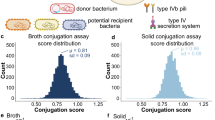Summary
Large F plasmids such as F′128 stimulate precise excision of the transposons Tn5 and Tn10 in E. coli K12. This stimulation occurs when the transposons are either on the F′128 plasmid or the bacterial chromosome. Stimulation of precise excision is dependent upon conjugal transfer proficient F′ plasmids. Tra− mutations which are defective in conjugal transfer negate this F′128 plasmid stimulation effect. F′128 traS mutations, which are surface exclusion defective and thus permit matings between male cells, thereby increasing conjugal transfer, increase the F plasmid stimulation effect. When the F′ plasmid is present in a cell with the small plasmid, pRS31, carrying the traS to traZ region of F, stimulation of precise excision is no longer observed. This complementation-like activity by pRS31 is abolished by a Tn5 insertion in the traS gene. Data are presented supporting the notion that F′ plasmid stimulation of precise excision occurs in the recipient during conjugal transfer. F′128 traS also stimulates recA-dependent recombination between DNA sequences on the small, nontransferrable plasmid pRDK41, DNA sequences that are unrelated to those of the F plasmid. The F′ plasmid stimulation of precise excision of Tn5 is not seen with F+ but only with certain F's with large insertions of chromosomal DNA.
Similar content being viewed by others
References
Achtman M, Willets N, Clark AJ (1972) Conjugational complementation analysis of transfer-deficient mutant of Flac in E. coli. J Bacteriol 110:831–842
Achtman M, Skurray R, Thompson R, Helmuth R, Hall S, Beutin L, Clark A (1978) Assignment of tra cistrons to EcoR1 fragments of F sex factor DNA. J Bacteriol 133:1383–1392
Achtman M, Manning P, Edelbluth C, Herrlich P (1979) Export without proteolytic processing of inner and outer membrane proteins encoded by F sex factor tra cistrons in E. coli minicells. Proc Natl Acad Sci USA 76:4837–4841
Albertini A, Hofer M, Calos M, Miller J (1982) On the formation of spontaneous deletions: the importance of short sequence homologies in the generation of large deletions. Cell 29:319–328
Berg D, Egner C, Lowe J (1983) Mechanism of F factor-enhanced excision of transposon Tn5. Gene 22:1–7
Czonka LN, Clark AF (1979) Deletions generated by the transposon Tn10 in the srl—recA region of the E. coli chromosome. Genetics 93:321–343
Doherty M, Morrison P, Kolodner R (1983) Genetic recombination of bacterial plasmid DNA: physical and genetic analysis of the products of plasmid recombination. J Mol Biol 167:539–560
Egner C, Berg D (1981) Excision of transposon Tn5 is dependent on the inverted repeats but not on the transposase function of Tn5. Proc Natl Acad Sci USA 78:459–463
Fishel A, James A, Kolodner R (1981) RecA independent general genetic recombination of plasmids. Nature 291:184–186
Foster T, Lundblad V, Hanley S, Halling M, Kleckner N (1981) Three Tn10 associated excision events: relationship to transposition and role of direct and inverted repeats. Cell 23:215–227
Hopkins J, Clements M, Liang T, Isberg R, Syvanen M (1980) Recombination genes on the E. coli sex factor specific for transposable elements. Proc Natl Acad Sci USA 77:2814–2818
Hopkins J, Clements M, Syvanen M (1983) New class of mutations in Escherichia coli (uup) that affect precise excision of insertion elements and bacteriophage Mu growth. J Bacteriol 153:384–389
Horii ZI, Clark AJ (1973) Genetic analysis of the recF pathway to genetic recombination in E. coli K-12: isolation and characterization of mutants. J Mol Biol 80:327–344
James A, Morrison P, Kolodner R (1982) Genetic recombination of bacterial plasmid DNA: analysis of the effect of recombination-deficient mutations on plasmid recombination. J Mol Biol 160:411–430
Kleckner N (1981) Transposable elements in procaryotes. Ann Rev Genet 15:341–404
Manning P, Kusecek B, Morelli G, Fisseau C, Achtman M (1982) Analysis of the promoter-distal region of the tra operon of the F sex factor of E. coli K12 encoded by EcoR1 restriction fragments f17, f19 and f2. J Bacteriol 150:76–88
Miller JH (1972) Experiments in molecular genetics. Cold Spring Harbor Laboratory, Cold Spring Harbor, New York
Moore DB, Sowa B, Ippen-Ihler K (1981a) The effect of tra mutations on the synthesis of the F-pilin membrane polypeptide. Mol Gen Genet 184:260–264
Moore DB, Sowa B, Ippen-Ihler K (1981b) Location of an F-pilin pool in the inner membrane. J Bacteriol 146:251–259
Porter RD (1981) Enhanced recombination between F42 and λplac5: dependence on F42lac fertility functions. Mol Gen Genet 184:355–358
Seifert HS, Porter RD (1984) Enhanced recombination between λplac5 and F42: identification of cis- and trans-acting factors. Proc Natl Acad Sci USA 81:7500–7504
Skurray R, Nagashi H, Clark A (1976) Molecular cloning of DNA from F sex factor of E. coli. Proc Natl Acad Sci USA 73:63–67
Author information
Authors and Affiliations
Additional information
Communicated by G.R. Smith
Rights and permissions
About this article
Cite this article
Syvanen, M., Hopkins, J.D., Griffin, T.J. et al. Stimulation of precise excision and recombination by conjugal proficient F′ plasmids. Mol Gen Genet 203, 1–7 (1986). https://doi.org/10.1007/BF00330376
Received:
Issue Date:
DOI: https://doi.org/10.1007/BF00330376



